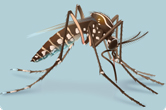Occupational Health Watch: September 2016
Preventing Zika Infection Among Workers
 The continued spread of the Zika virus has spurred creation of new materials on protecting a variety of workers, including those who work outdoors or on cruise ships, and healthcare and laboratory workers.
The continued spread of the Zika virus has spurred creation of new materials on protecting a variety of workers, including those who work outdoors or on cruise ships, and healthcare and laboratory workers.
The Zika virus is spread to humans primarily through mosquito bites, but the virus has been detected in body fluids including blood. Work-related transmission has been documented in a research laboratory setting via a needle stick. Healthcare and laboratory employers need to assess Zika risk and protect employees under their blood-borne pathogen exposure control plan.
Outdoor workers are at risk in areas with Zika. So far, that does not include California. In our state, Zika virus infections acquired from mosquitos have been documented to date only among people infected while travelling outside the United States (and possibly to Florida). For outdoor workers and workers who travel to Zika areas, employers need to inform them of the risk and provide them with the means to prevent mosquito bites and possible infection.
Many people infected with Zika do not know they are experiencing its mild symptoms. If a pregnant woman is infected, however, the virus can pass to her fetus and cause serious birth defects. CDC recommends that pregnant women not travel to areas where Zika is transmitted via mosquitos. CDPH's Zika website includes information for healthcare providers on what to do if they treat someone suspected to have Zika.
Available resources for employers and workers include the following:
Illustration: Zika is spread by the bite of an infected mosquito or exposure to blood.
Resources
NIOSH Zika web page
NIOSH/OSHA Zika fact sheet
CDPH Zika web page
Email Occupational Health Watch (OHW@cdph.ca.gov) with feedback or change of address.